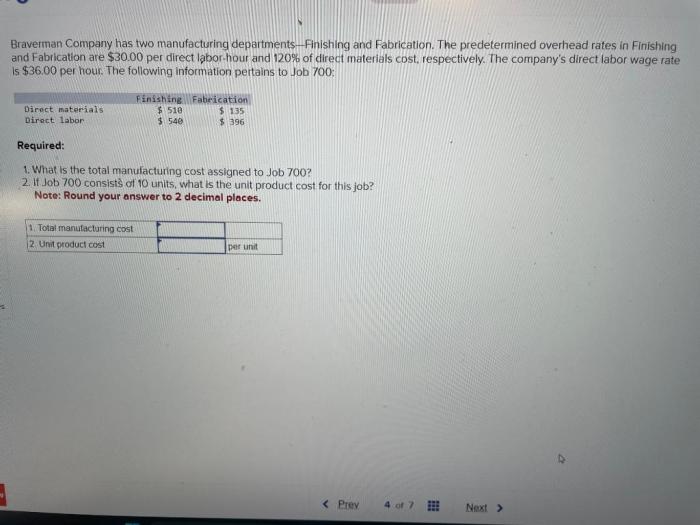Braverman company has two manufacturing departments – Braverman Company’s manufacturing operations are divided into two distinct departments, each playing a crucial role in the company’s overall production processes. This analysis delves into the specific functions, interrelationships, and performance of these departments, providing insights into the intricate workings of Braverman Company’s manufacturing operations.
The first department, specializing in raw material processing, undertakes the initial transformation of incoming materials into intermediate components. The second department, focused on final assembly, meticulously combines these components to create finished products that meet exacting quality standards.
Manufacturing Departments Overview

Braverman Company operates two distinct manufacturing departments: Fabrication and Assembly. The Fabrication department is responsible for transforming raw materials into components, while the Assembly department integrates these components into finished products.
Fabrication Department
- Converts raw materials into components using specialized machinery and techniques.
- Involves processes such as cutting, welding, molding, and finishing.
- Ensures precision and quality control in component production.
Assembly Department, Braverman company has two manufacturing departments
- Integrates components into finished products according to design specifications.
- Utilizes assembly lines, tools, and testing equipment.
- Maintains product quality and adherence to production schedules.
The two departments work interdependently, with the Fabrication department providing components to the Assembly department for final assembly.
Production Processes: Braverman Company Has Two Manufacturing Departments

Fabrication Department
- Cutting:Uses precision cutting machines to shape raw materials.
- Welding:Joins metal components using welding techniques.
- Molding:Creates complex shapes using molding processes.
- Finishing:Applies protective coatings or finishes to enhance durability and aesthetics.
Assembly Department, Braverman company has two manufacturing departments
- Assembly:Integrates components into products using assembly lines.
- Testing:Conducts quality control tests to ensure product functionality.
- Packaging:Prepares finished products for storage and shipment.
The production processes are optimized to ensure efficient and high-quality manufacturing.
Department Performance Analysis
The performance of each department is evaluated based on key metrics:
Efficiency
- Fabrication:Production output per unit of raw material.
- Assembly:Production output per unit of time.
Productivity
- Fabrication:Value of finished components produced per unit of labor.
- Assembly:Value of finished products produced per unit of labor.
Quality Control
- Fabrication:Percentage of components meeting quality standards.
- Assembly:Percentage of finished products meeting quality standards.
Regular performance analysis helps identify areas for improvement and optimize production processes.
Resource Allocation and Management
Resources are allocated between departments based on:
Production Volume
- Departments with higher production volume receive more resources.
- Ensures efficient resource utilization.
Production Complexity
- Departments producing complex products receive more skilled labor and specialized equipment.
- Improves product quality and reduces production time.
The current resource management system effectively supports production operations, but ongoing evaluation ensures optimal resource utilization.
Department Collaboration and Communication

Collaboration between departments is facilitated through:
Regular Meetings
- Cross-departmental meetings discuss production plans, quality issues, and improvement initiatives.
- Enhances information sharing and coordination.
Communication Channels
- Dedicated communication channels (e.g., email, instant messaging) enable seamless communication.
- Facilitates quick problem-solving and decision-making.
Fostering collaboration has led to improved production efficiency and product quality.
Department Integration

The two departments are moderately integrated:
Shared Resources
- Departments share certain resources (e.g., equipment, storage space) to optimize utilization.
- Reduces costs and improves resource efficiency.
Cross-Training
- Employees are cross-trained to work in both departments.
- Enhances flexibility and adaptability in production.
Further integration could enhance collaboration and optimize production processes.
Clarifying Questions
What are the primary functions of the two manufacturing departments?
The first department specializes in raw material processing, transforming incoming materials into intermediate components. The second department focuses on final assembly, combining components to create finished products.
How are resources allocated between the departments?
Resource allocation considers factors such as production volume, equipment availability, and workforce capacity to ensure optimal utilization and minimize bottlenecks.
What measures are in place to foster collaboration between departments?
Regular communication channels, cross-functional teams, and shared performance metrics promote collaboration and ensure seamless coordination throughout the manufacturing process.